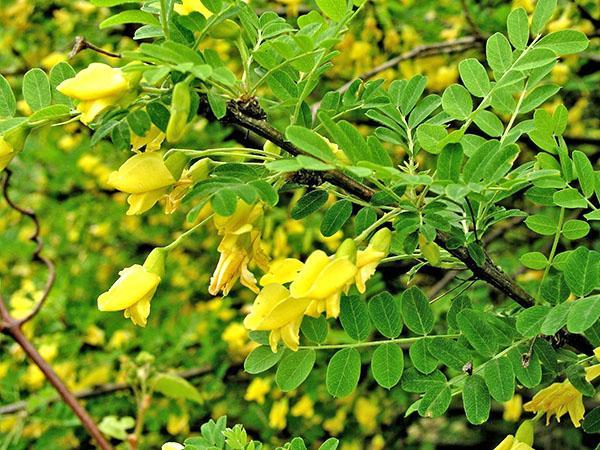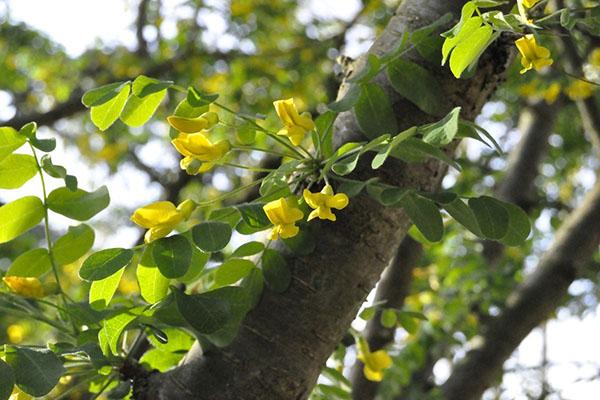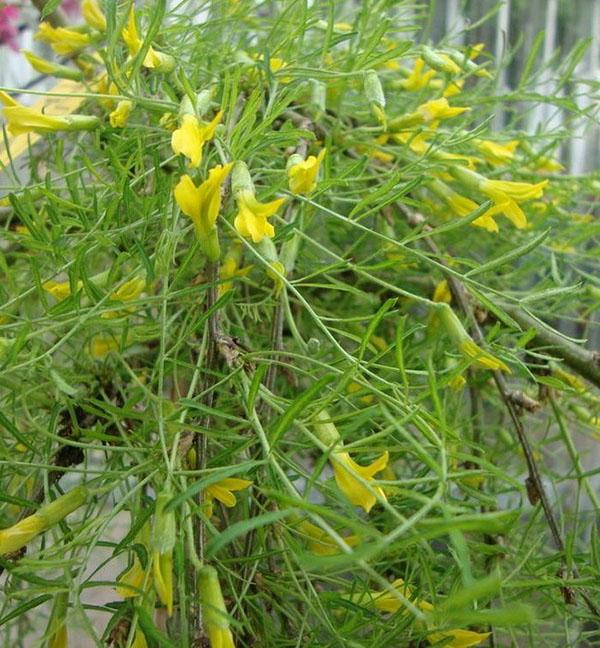Yellow acacia - tree caragana: description and features of cultivation
 In many regions of Russia, from the Far East to the central part of the country, the caragan acacia is found. In the wild, large shrubs can be seen in the undergrowth of pine, mixed and deciduous forests, in clearings, in mountainous areas and on forest edges.
In many regions of Russia, from the Far East to the central part of the country, the caragan acacia is found. In the wild, large shrubs can be seen in the undergrowth of pine, mixed and deciduous forests, in clearings, in mountainous areas and on forest edges.
The unpretentious, fast-growing acacia, at the end of spring, covered with thousands of yellow, moth-like flowers, was appreciated by connoisseurs of ornamental plants in 1752 and introduced into culture. Today shrubs can be seen not only in parks and squares. Tree-like Karagan, or Caragana arborescens is actively used to fix the slopes of ravines, as a living protection from the wind and to create green hedges.
Description of the yellow acacia caragan

Flowers and leaves are collected in bunches, and the young foliage is noticeably pubescent, and by summer it becomes dense and smooth. In place of moth corollas, linear-cylindrical beans are formed. As the seeds ripen, they turn brown, and in August they open and, rolling, scatter small oval beans around. Thanks to them, the plant received the popular name "pea plant" or "pea acacia".
 The unpretentiousness, plasticity and decorativeness of this culture made the yellow acacia or caragana very popular in the second half of the last century. Today, landscape designers and ordinary summer residents have at their disposal original varieties of this plant.
The unpretentiousness, plasticity and decorativeness of this culture made the yellow acacia or caragana very popular in the second half of the last century. Today, landscape designers and ordinary summer residents have at their disposal original varieties of this plant.
The foliage of the yellow acacia often remains green until late autumn, right up to abscission.
In weeping yellow acacia, young flexible shoots fall beautifully to the very ground, forming a semblance of a living tent. The tree-like Walker caragana acacia looks even more exquisite. The weeping branches of this plant are covered with needle-like foliage, which gives the shrub up to 2.5 meters in height a special openwork.
How to plant a yellow acacia
 Karagana is very undemanding, therefore it is often planted along roads, used to protect fields from wind erosion and to strengthen various slopes. And yet, in order for the plant to fully manifest its qualities, well-lit areas with light moisture-consuming soil are chosen for the shrub.
Karagana is very undemanding, therefore it is often planted along roads, used to protect fields from wind erosion and to strengthen various slopes. And yet, in order for the plant to fully manifest its qualities, well-lit areas with light moisture-consuming soil are chosen for the shrub.
Low-lying areas are not suitable for acacia caragana, where shrubs can suffer from flooding and the proximity of groundwater.
If you have to plant an acacia for a living wall, leave a distance of 50–70 cm between the plants. Gradually, the crowns of the bushes will close, and regular haircut will help to form a fence of the desired height, width and shape.
 The maximum width of a yellow acacia bush can be 5 meters. This is taken into account in single plantings so that the surrounding plants do not fall into the shadow of a fast-growing caragana, which can live up to 50 years.
The maximum width of a yellow acacia bush can be 5 meters. This is taken into account in single plantings so that the surrounding plants do not fall into the shadow of a fast-growing caragana, which can live up to 50 years.
The optimal time for planting a shrub:
- early spring, when the ground has thawed enough, but the buds on the acacia have not yet awakened;
- autumn, when the growing season ends and leaves fall.
Before planting a yellow acacia, prepare planting pits with a depth and width of at least 50 cm.Sandy soil and sandy loam are mixed with organic matter, a small amount of bottom peat and 100-200 grams of complex mineral fertilizers. In heavy dense soil, in addition to the above, you need to add sand. This allows the plant to actively develop the root system and quickly take root in a new place. A drainage layer 10-15 cm thick is laid at the bottom of the pit.
After the seedlings are immersed in the pits:
- they are covered with prepared soil;
- the soil is rammed;
- planting sites are watered abundantly;
- near-trunk circles mulch thickly.

Pea acacia or caragana is not afraid of deepening. The root growth formed in this case will make the bush more powerful, voluminous, however, it will complicate the cultivation of the standard form.
Care when growing yellow acacia

Further care will not complicate even a novice gardener. Yellow acacia requires:
- regular watering throughout the warm season;
- sanitary and formative pruning;
- protection against diseases and pests;
- weeding from under the crown.
The culture is not afraid of heat and drought, but with a prolonged lack of water, it can shed its foliage ahead of time. Therefore, in dry summers, the shrubs are watered 2-3 times a month, and the trunks are covered with mulch, which helps to preserve moisture.
Care for the cultivation of yellow acacia is not complete without annual feeding. In spring, under the crown, caragana add rotted compost and a mineral complex, while the plant does not require additional portions of nitrogen. Like all legumes, the yellow acacia independently accumulates this element and enriches the soil with it.
Pruning yellow acacia caragana
 Karagana is incredibly plastic. She tolerates shaping easily. Can be grown as a regular shrub. Become a living wall or a spectacular standard tree.
Karagana is incredibly plastic. She tolerates shaping easily. Can be grown as a regular shrub. Become a living wall or a spectacular standard tree.
When to cut yellow acacia? It is best to do this in early spring, before the juices begin to move, and in autumn, to remove damaged, weak and dried branches. Hedges and standard plants are cut annually. In the first case, this allows you to maintain the shape of the fence and avoid exposing its lower part. To give the shrub the appearance of an elegant tree, you have to carefully remove the root growth. At the same time, form the crown of a yellow acacia.
Adult shrubs are subjected to rejuvenating pruning by sawing out old, heavily bare, lichen-covered trunks.
Reproduction of yellow acacia
 Caragana reproduces by seeds, cuttings and grafting.
Caragana reproduces by seeds, cuttings and grafting.
Semi-lignified shoots cut from a healthy bush can be:
- treat with a stimulant;
- root in light soil during spring and summer;
- plant in a permanent place in the fall.
Ripe seeds are also easy to use for growing new young caragana acacia plants. They are soaked in water for several hours and sown in a light loose substrate in spring. After a year, the seedlings are ready for planting in a permanent place.
Vaccination is indispensable when it comes to the propagation of Walker acacia and weeping forms on a stem.
How to destroy Karagan? The whole yard is in Karagan.